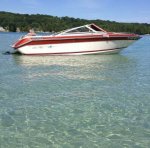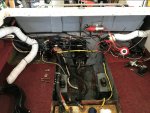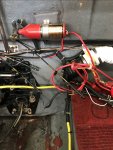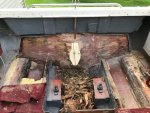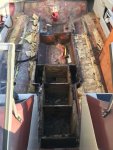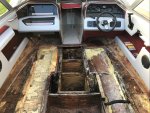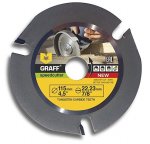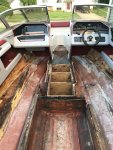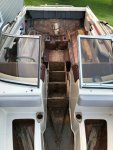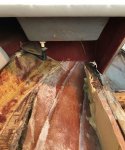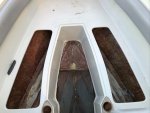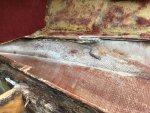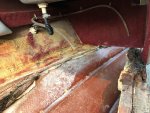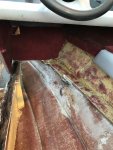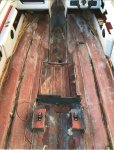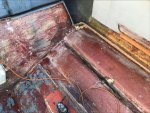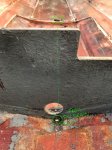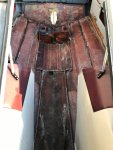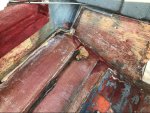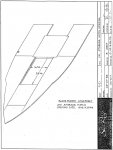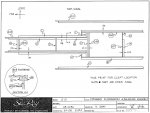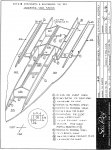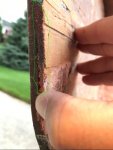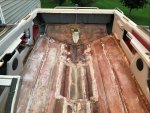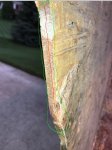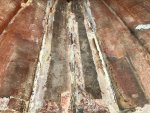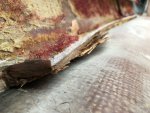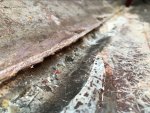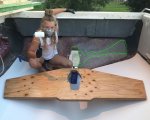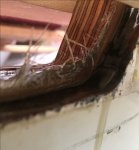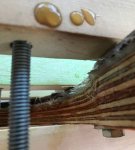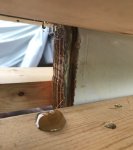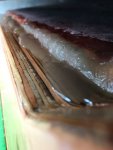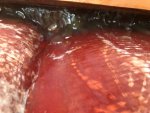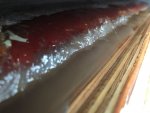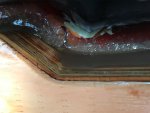OK, so even though it’s been a while since my last update, I’ve been busy working on several different aspects of the rebuild process in the background as time has allowed.
With regard to the grinding, my plan was to start with the transom and then work my way to the bow. I figured that since this was my first time ever using an angle grinder it’d be good to work on something large and relatively flat. I alternated between a new 4.5” grinder I bought (which is much less fatiguing on the hands and arms) and a borrowed a 6” behemoth grinder using 24 and 40 grit ceramic grinding disks.
The transom grinding started good and was going along fine until I got to the port side, where I ran into my first snag.
Underneath the wood that I was grinding off I discovered that the port side of the transom had developed a huge fiberglass void from a poorly sealed hole (or holes) that extended from the upper and outer edge of the transom all the way across and downward to the gimbal opening, which had then compromised the middle two gimbal mounting bolt holes. As I ground out the delaminated fiberglass, the grinder was actually flinging water that was STILL resting in the bottom of the void between the inner and outer fiberglass!
After getting that all removed, I spent the next couple of weekends grinding the hull in preparation for the new stringer, bulkhead, and floor tabbing from stern to bow as I had planned. Those were some long days and my back is happy to say that, outside of a few left over touch-up spots, it’ll NEVER have to do that job again, hallelujah! I’ll provide some overall before and after pictures for that aspect of the demolition and hull prep work in a future update.
In the meantime, I was researching the best way to restore the transom to a point where it was ready to accept a new transom core.
The formula I decided to use for the repair was thickened resin (using cabosil) with a fair amount of .25” chopped fiberglass strands added for strength and flexibility. It took 4 or 5 iterations of slathering a 10-16oz mixture into the void and various low spots with a paint stick, fairing out the edges, covering it all with waxed paper and smoothing it out with a flat edge, then coming back the next day and sanding out any pockets and checking for flatness until it was FINALLY built back up to where it should be.
While all of that was going on, I was getting all sorts of help and advice on building and installing the new transom board.
The pattern of the new transom board was made from a template that was traced and cut out of foam board, then digitized into a CNC file, and finally cut out of 7-ply marine grade plywood. The specs called for a 1.5” thick board so we cut two .75” copies out and then clamped them together using TiteBond III waterproof wood glue as the bonding agent. The next day, to make the future fiberglass laminating easier, we routered the entire outer parameter flat and routed a rounded edge on the top and side front edges. When all was said and done it was difficult to see the bonding layer between the two boards, nice!
For the gimbal (or bowling pin) cutout, I test-fit the board against the transom and blocked it into place with wood shims, then had my wife trace the cutout and the bolt holes from the outside while I leaned on it from the inside. I then took the board back out and drilled out just two of the six bolt holes (diagonally opposed) to a smaller dimension, then bolted the transom back into the boat and retraced the opening and drilled out the remaining bolt holes. Once again, I took the sucker back out of the boat put it on a couple of saw horses and used a jig saw to cut out the gimbal opening to within .25”, then put it back in the boat, bolted it up, and used a 2” router bit to remove the remaining transom wood following original fiberglass cutout as the trace. It was definitely time consuming, but I don’t like doing things twice and it came out as close to perfect as I could get.
Finally, after all of that and resin-coating both sides of the board earlier this week, Lilly and I were able to put it in last night!
I followed the advice I was given and wetted out the back of the new board, then wetted out two layers of 1.5oz CSM, then wetted out the transom, and clamped that ***** into place with my “custom” 2x4 clamping system and the gimbal bolts (which I slathered with grease beforehand).
Needless to say, resin squished out of everywhere!
Note: You can see the pooled resin around the parameter denoted on the clamp picture (red) and the clamping “feet” attached to the long 2x4’s to apply pressure to the outer edge of the transom “wings” (green).
I put the cover on and put a small space heater in the boat overnight and this morning the resin was like concrete!
Whew, consider yourselves caught up! The next steps are puttying around the parameter of the board, tabbing it in, and overlaying it with a couple layers of 1708, which I hope to do over the weekend.




















